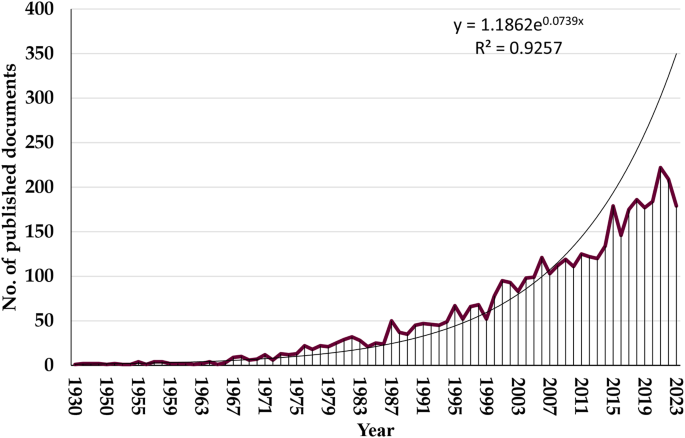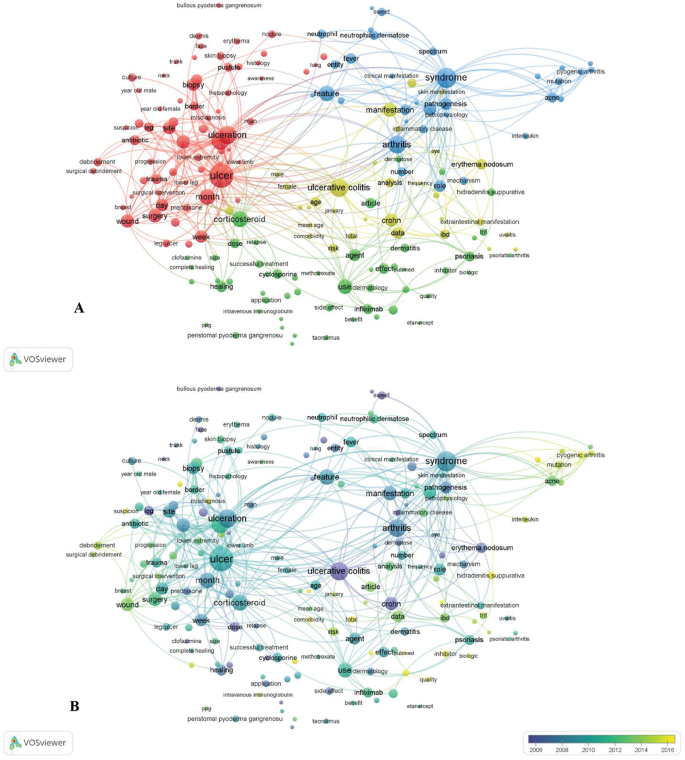- Letter to the Editor
- Open access
- Published:
Analyzing global research trends and focal points of pyoderma gangrenosum from 1930 to 2023: visualization and bibliometric analysis
Journal of Translational Medicine volume 22, Article number: 508 (2024)
To the Editor, I read with great interest the publication entitled “An approach to the diagnosis and management of patients with pyoderma gangrenosum from an international perspective: results from an expert forum” [1]. Pyoderma gangrenosum is an ulcerative, cutaneous condition with distinctive clinical characteristics first described in 1930 [2]. Due to the importance of the subject, this published study was searched in databases, and I did not find any bibliometric studies on this topic. In recent years, researchers have successfully applied bibliometric analysis in various domains, contributing to the development of novel theories and assessing research frontiers, including in the dermatology field. Nonetheless, comprehensive bibliometric analyses of P. gangrenosum have not been performed. This study addresses this gap by conducting a thorough bibliometric analysis in the field of P. gangrenosum at the global level. The goal is to assist researchers in swiftly grasping the knowledge structure and current focal points in the field, generating new research topic ideas, and enhancing the overall quality of research on P. gangrenosum.
This bibliometric analysis sought to delineate research endeavors concerning P. gangrenosum, pinpoint the primary contributing countries, and discern prevalent topics within this domain. Using a descriptive cross-sectional bibliometric methodology, this study extracted pertinent documents from the Scopus database covering the period from 1930 to December 31, 2023. The search strategy included keywords related to ‘pyoderma gangrenosum.’ VOSviewer software (version 1.6.20) was used to illustrate the most recurring terms or themes [3]. The scope of the retrieved documents was restricted to including only journal research articles while ignoring other forms of documents.
Overall, 4,326 papers about P. gangrenosum were published between 1930 and 2023. Among these were 3,095 (71.54%) original papers, 548 (12.67%) letters, 477 (11.03%) reviews, and 206 (4.76%) other kinds of articles, such as conference abstracts, editorials, or notes. With 3,454 publications, English was the most often used language, followed by French (n = 253), German (n = 190), and Spanish (n = 163), accounting for 93.85% of all related publications.
Figure 1 shows the distribution of these publications. Between 1930 and 2023, there were steadily more publications on P. gangrenosum (R2 = 0.9257; P value < 0.001). Growth trends and productivity trends in P. gangrenosum-related publications have been influenced by developments in medical research, clinical practice and patient care [4, 5]. All of these factors have advanced our knowledge of the condition, enhanced our methods of treatment, and helped to create standardized findings for clinical studies.
The top 10 countries with the most publications on P. gangrenosum are listed in Table 1. These are the USA (n = 1073; 24.80%), the UK (n = 345; 7.98%), Japan (n = 335, 7.74%), and Germany (n = 296; 6.84%). With 65 articles, the Mayo Clinic in the USA led the institutions; Oregon Health & Science University in the USA and Università degli Studi di Milano in Italy followed with 60 articles each.
To create a term co-occurrence map in VOSviewer 1.6.20, terms had to appear in the title and abstract at least forty times by binary counting. The network was visualized by building the map using terms with the highest relevance scores. Large bubbles for often cooccurring terms and close spacing between terms with high similarity were guaranteed by the algorithm. The larger circles in Fig. 2A represent frequently occurring terms in titles and abstracts. Four primary topic clusters—“Treatment modalities” (green cluster), “epidemiology and clinical presentation” (blue cluster), “improved diagnostic methods” (red cluster), and “the links between P. gangrenosum and other morbidities such as inflammatory bowel disease or autoimmune conditions” (yellow cluster)—are distinguished by color.
Mapping of terms used in research on P. gangrenosum. A: The co-occurrence network of terms extracted from the title or abstract of at least 40 articles. The colors represent groups of terms that are relatively strongly linked to each other. The size of a term signifies the number of publications related to P. gangrenosum in which the term appeared, and the distance between two terms represents an estimated indication of the relatedness of these terms. B: Mapping of terms used in research on P. gangrenosum. The terms “early” (blue) or “late” (red) years indicate when the term appeared
Interestingly, after 2012, terms related to “treatment modalities” and “epidemiology and clinical presentation” have gained more attention than in the past, which focused on “improved diagnostic methods” and “the links between P. gangrenosum and other morbidities such as inflammatory bowel disease or autoimmune conditions” (pre-2012). Figure 2B shows this tendency.
In conclusion, there has recently been an increase in P. gangrenosum research, especially in the last decade. The current focus of research is on treatment challenges, obstacles to diagnosis, and connections to underlying diseases. Furthermore, efforts are being made to create core outcome sets and standardized diagnostic criteria for clinical trials. These patterns demonstrate continuous attempts to comprehend, identify, and treat this illness with greater effectiveness. This recent increase in research has important implications for clinical practice. Clinicians can improve patient care by remaining current in emerging trends and areas of interest. Moreover, an in-depth analysis of previous studies can identify knowledge gaps, directing future research efforts toward the most important issues. In the end, a deeper comprehension of the body of research can result in better clinical judgment based on best practices, which could enhance patient outcomes and advance the dermatological field.
Data availability
This published article contains all the information produced or examined in this research. Additional datasets utilized during this study can be obtained from the corresponding author.
References
Haddadin OM, Ortega-Loayza AG, Marzano AV, Davis MDP, Dini V, Dissemond J, Hampton PJ, Navarini AA, Shavit E, Tada Y, et al. An approach to diagnosis and management of patients with pyoderma gangrenosum from an international perspective: results from an expert forum. Arch Dermatol Res. 2024;316(3):89.
Brunsting LA. Pyoderma (Echthyma) Gangrenosum. Arch Derm Syphilol. 1930;22(4):655–80.
van Eck NJ, Waltman L. Software survey: VOSviewer, a computer program for bibliometric mapping. Scientometrics. 2010;84(2):523–38.
Kridin K, Cohen AD, Amber KT. Underlying systemic diseases in Pyoderma Gangrenosum: a systematic review and Meta-analysis. Am J Clin Dermatol. 2018;19(4):479–87.
McKenzie F, Arthur M, Ortega-Loayza AG. Pyoderma Gangrenosum: what do we know now? Curr Dermatol Rep. 2018;7(3):147–57.
Acknowledgements
The author thanks An-Najah National University for all the administrative assistance during the implementation of the project.
Funding
No support was received for conducting this study.
Author information
Authors and Affiliations
Contributions
Sa’ed H. Zyoud significantly contributed to the conceptualization and design of the research project, overseeing data management and analysis, generating figures, and making substantial contributions to the literature search and interpretation. Furthermore, Sa’ed H. Zyoud authored the manuscript, which he reviewed and approved as the sole author.
Corresponding author
Ethics declarations
Ethics approval and consent to participate
The ethics committee’s approval was unnecessary because the study did not include human interactions.
Consent for publication
Not applicable.
Competing interests
The authors declare that they have no competing interests.
Additional information
Publisher’s Note
Springer Nature remains neutral with regard to jurisdictional claims in published maps and institutional affiliations.
Rights and permissions
Open Access This article is licensed under a Creative Commons Attribution 4.0 International License, which permits use, sharing, adaptation, distribution and reproduction in any medium or format, as long as you give appropriate credit to the original author(s) and the source, provide a link to the Creative Commons licence, and indicate if changes were made. The images or other third party material in this article are included in the article’s Creative Commons licence, unless indicated otherwise in a credit line to the material. If material is not included in the article’s Creative Commons licence and your intended use is not permitted by statutory regulation or exceeds the permitted use, you will need to obtain permission directly from the copyright holder. To view a copy of this licence, visit http://creativecommons.org/licenses/by/4.0/. The Creative Commons Public Domain Dedication waiver (http://creativecommons.org/publicdomain/zero/1.0/) applies to the data made available in this article, unless otherwise stated in a credit line to the data.
About this article
Cite this article
Zyoud, S.H. Analyzing global research trends and focal points of pyoderma gangrenosum from 1930 to 2023: visualization and bibliometric analysis. J Transl Med 22, 508 (2024). https://doi.org/10.1186/s12967-024-05306-4
Received:
Accepted:
Published:
DOI: https://doi.org/10.1186/s12967-024-05306-4

